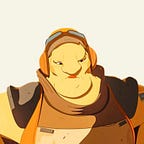The Power and Precarity of Geode in “Into the Dark” by Claudia Gray
*Major spoiler warning for Into the Dark by Claudia Gray*
When we first meet Geode, it seems like a joke. Through almost all of Into the Dark, we cannot help but wonder whether everyone is just playing along. Is Geode really alive and sentient? Or is he just a rock? Geode’s appearances throughout the book thread the line between serious and ironic. In a moment of danger, his “ominous silence [speaks] volumes”. His sudden appearance in the dining area of the Vessel prompts Reath to wonder if one of the crew moved him there, or if he’d somehow moved there himself. And though the crew of the vessel treat Geode quite seriously, we can never be sure of Claudia Gray’s intentions. Leox describes Geode with what seem like contradictory statements, which Reath points out, only to be brushed off. We are led to ask: do the crew believe Geode is a conscious being, or is this an elaborate performance with an underlying message about the power of collective imagination? If Geode is alive, how are Leox and Affie communicating with him? Is he really navigating the ship? Or is this perhaps a carefully constructed mystery, operating at a meta-level, that Claudia Gray simply intends not to explain? And so Geode occupies the edge of reality in both the Star Wars galaxy and for us as readers, alive but not alive, ironic but equally un-ironic. This tension creates uncertainty, but it also entertains and enthrals us. He is the navigator of the ship, and so our fate rests in Geode, as uncertain and unknowable as the darker reaches of the Outer Rim we are journeying towards. But though he represents an inscrutable Other, we love Geode. And that is because he is unlike anything we have ever seen in Star Wars before. He destabilizes the foundations of what we know to be true about being-ness.
In the Star Wars galaxy, we are used to everything being human or nonhuman. I use “human” not in the sense of the human race, but to say that most beings in Star Wars are coded as ‘human’ whether they appear physically in a human body, a droid, or a horned Togruta: each carry distinct vestiges of what we might consider indicators of humanity. When the aliens are not human, they are decisively un-human. Creatures like the Rancor, the Krayt Dragon, and Mynocks draw upon the imagery of Earth-ian animals from nature and mythology. And so, though Star Wars teems with a diversity of alien species, the dichotomy of the human and the nonhuman ultimately prevails. In Into the Dark, Gray breaks us free from this binary. As readers, we are never quite sure what to make of Geode. To what category does he belong — human, nonhuman, inanimate? Unlike human-like droids C-3PO, R2-D2, or HK-47, Geode does not have limbs, or indeed any visible or discernible means of motion. Unlike most alien or droid species, Geode does not speak. He does not have a mouth, or any moveable body feature that might indicate mood, intent, or thoughts. Gray does not let us see Geode’s thoughts either, or hear his voice. Instead, what we know about him must be assumed from narration by his companions, Leox and Affie, two distinctly unreliable and quirky personalities. We have to accept their proposition that he has a consciousnes, that he communicates — much like Reath, though, we are never certain. Gray leans into the irony of this uncertainty, which further complicates our ability to know.
But in the end, when it seems like Reath is about to die, Geode saves the young Padawan’s life — and because we identify with Reath, by extension he saves us. We feel the sense of relief, surprise, and joy that Reath does when he finds Geode’s looming, sturdy presence blocking the vacuum that spelled certain death. And in that moment, we can know that Geode is not simply a rock, nor an extended in-joke played by the crew of the Vessel or even by Claudia Gray herself. In the climactic moment of the book, Geode is cemented as alive, as real, and as heroic. All of the things that we could not consider possible for a rock — an “inanimate” “object” — are vibrant and striking in Geode’s presence. The mystery that has built since his first introduction is resolved, and we feel a sense of relief that we can confirm Geode’s sentience and place him comfortably in the “human” category.
And yet — can we? Does Geode share any characteristics with what we use to define humanity, inside and outside of the Star Wars universe? Equally, he is not an inanimate object. Geode is neither human nor nonhuman. He challenges us to rethink and problematize the human as a construct, queering the bounds of what we think of as identity and as being. Geode reminds us just how precarious the construct of humanity is. This challenge to re-examine, to reconfigure and to destabilize is a common theme across the High Republic. In Into the Dark we leave Cohmac, Dez, Affie and Orla deeply uncertain about things they’ve thought to be truth or fact since their youth.
And so we embark into the next chapter of the High Republic still in a state of unknowing, our ability to define and to know as unstable as the Republic and many of its Jedi — yet comfortable with the certainty that wherever we’re headed, Geode will be there for us.
